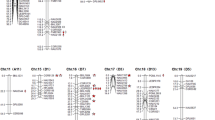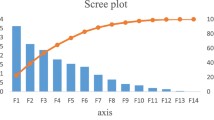Abstract
Six short season cotton cultivars (Gossypium hirsutum L.) were crossed in a dillalel crossing system to evaluate inheritance and interrelationship of phenotype and genotype of fiber quality traits (fiber length, uniformity index, fiber strength, micronaire and fiber elongation) and their correlation with earliness and yield traits. The study was carried out from year 2005 to 2008. The experiment design was a randomized complete block design with three replications. Additive, dominance and epistasis effects were analyzed with ADAA model. The results showed that fiber quality traits were mainly controlled by dominant genetic effects and also had a definitely proportion additive genetic effects. Micronaire, fiber length, fiber strength and fiber elongation had the highest broad sense heritability (HB) and by environment interaction (HBE) estimates, 0.618 (HB) and 0.267 (HBE) for micronaire, 0.510 (HB) and 0.287 (HBE) for fiber length, 0.452 (HB) and 0.316 (HBE) for fiber strength, 0.294 (HB) and 0.494(HBE) for fiber elongation, respectively. Narrow sense heritability (HN) was 0.258 for fiber elongation, 0.136 for fiber length, 0.127 for fiber strength and 0.110 for micronaire. Some F1 hybrids (A1×B2), (A2×A3) and (B1×A3) for fiber length, F1 (A2×B3) and (B1×B2) for fiber strength, F1 (B1×A2), (A2×B2), (A2×B3), (B1×A3), (B2×A3) and (B1×B2) for micronaire and F1 (A1×A2), (A1×A3), (A1×B1), (A1×B3) and (B2×A3) for fiber elongation had significant positive heterozygous dominance effects and affected by environment. Some F1 hybrids (A1×A2), (A1×B1), (A1×B3), (B1×A2) and (B2×A3) for fiber length, (A1×A3), (A1×B1) and (A1×B3) for fiber strength, (A1×A3), (A1×B1), (A1×B2) and (B2×B3) for micronaire and (A2×A3), (A2×B2), (A2×B3) and (B1×B2) for fiber elongation had significant positive epistatic effects. Among fiber quality traits, fiber length with fiber strength, uniformity index with fiber strength and micronaire, fiber strength with micronaire showed a positive and significant correlation. Only elongation had a significant negative correlation with fiber quality traits. Fiber quality traits had a negative correlation with earliness traits except micronaire. Fiber length and strength showed a significant negative correlation with lint yield, lint yield before frost, lint percentage and boll number. Uniformity index, micronaire and fiber elongation had a significant positive correlation with yield traits except boll weight and lint percentage. The results showed that the higher the yield and the earlier the maturing and the worse the fiber quality. Therefore, selections of fiber properties and integration of high yield, good fiber quality and early maturing traits should be performed in higher generations in short season cotton variety breeding program.

Similar content being viewed by others
References
Aguado A, Los Santos BD, Gamane D, Garcı′a del Moral LF, Romero F (2010) Gene effects for cotton-fiber traits in cotton plant (Gossypium hirsutum L.) under Verticillium conditions. Field Crops Res 116:209–217
Al-Rawi KM, Kohel RJ (1969) Diallel analyses of yield and other agronomic characters in Gossypium hirsutum L. Crop Sci 9(6):779–783
Breeze E, Harrison E, McHattie S (2011) High-resolution temporal profiling of transcripts during arabidopsis leaf senescence reveals a distinct chronology of processes and regulation. Plant Cell 23:873–894
Calhoun SD, Bowman DT (1999) Techniques for development of new cultivars. In: Smith WC (ed) Cotton: origin history, technology, and production. JohnWiley & Sons, Inc., New York, pp 361–414
DaCosta M, Huang BR (2007) Changes in antioxidant enzyme activities and lipid peroxidation for Bentgrass species in response to drought stress. J Amer Soc Hort Sci 3:319–326
Falkenberg NR, Piccinni G, Cothren JT, Leskovar DI, Rush CM (2007) Remote sensing of biotic and abiotic stress for irrigation management of cotton. Agric Water Manag 87:23–31
Gan S, Amasino RM (1997) Making sense of senescence. Molecular genetic regulation and manipulation of leaf senescence. Plant Physiol 113:313–319
Jenkins JN, McCarty JC, Wu J, Saha S, Gutierrez OA, Hayes R, Stelly DM (2007) Genetic effects of thirteen Gossypium barbadense L.chromosome substitution lines in topcrosses with Upland Cotton cultivars: II fiber quality traits. Crop Sci 47:561–570
Lee JA, Miller PA, Rawlings JO (1967) Interaction of combining ability effects with environment in diallel crosses of upland cotton. (Gossypium hirsutum L.). Crop Sci 7:477–481
May OL, Green CC (1994) Genetic variation for fiber properties in elite Pee Dee cotton populations. Crop Sci 34:684–690
Meredith WR Jr, Bridge RR (1971) Breakup of linkage block in cotton, Gossypium hirsutum L. Crop Sci 11:695–697
Meredith WR Jr, Bridge RR (1972) Heterosis and gene action in cotton Gossypium hirsutum L. Crop Sci 12:304–310
Miller PA, Lee JA (1964) Heterosis and combining ability in varietal top crosses of Upland cotton Gossypium hirsutum L. Crop Sci 4:646–649
Miller PA, Marani A (1963) Heterosis and combining ability in diallel crosses of upland cotton Gossypium hirsutum L. Crop Sci 3:441–444
Noodén LD, Guiamét JJ, John I (1997) Senescence mechanisms. Plant Physiol 101:746–753
Peabody PJ, Johnson PN (2002) Profitability of short season cotton genotypes on the high plains of Texas. Texas J Agri Nat Resour 15:7–14
Quisenberry JE (1975) Inheritance of fiber properties among crosses of Acala and high plains cultivars of upland cotton. Crop Sci 15:202–204
Saha S, Wu JX, Jenkins JN, McCarty JC, Hayes R, Stelly DM (2010) Genetic dissection of chromosome substitution lines of cotton to discover novel Gossypium barbadense L. alleles for improvement of agronomic traits. Theor Appl Genet 120:1193–1205
Saha S, Wu JX, Jenkins JN, McCarty JC, Hayes R, Stelly DM (2011) Delineation of interspecific epistasis on fiber quality traits in Gossypium hirsutum by ADAA analysis of intermated G. barbadense chromosome substitution lines. Theor Appl Genet 122:1351–1361
Saha S, Wu JX, Jenkins JN, McCarty JC, Hayes R, Stelly DM (2013) Interspecific chromosomal effects on agronomic traits in Gossypium hirsutum by AD analysis using intermated G. barbadense chromosome substitution lines. Theor Appl Genet 126:109–117
Song MZ, Fan SL, Yuan RH, Pang CY, Yu SX (2012) Genetic Analysis of Earliness Traits in Short Season Cotton (G. hirsutum. L). J Integr Agric 11(12):101–108
Tang B, Jenkins TN, Watson CE, McCarty JC, Creech RG (1996) Evaluation of genetic variances, heritabilities, and correlations for yield and fiber traits among cotton F2 hybrid populations. Euphytica 91:315–322
Ulloa M (2006) Heritability and correlations of agronomic and fiber traits in an okra-leaf upland cotton population. Crop Sci 4:1508–1514
Ulloa M, Meredith WR Jr (2000) Genetic linkage map and QTL analysis of agronomic and fiber quality traits in an intraspecific population. J. Cotton Sci 4:161–170
Ulloa M, Meredith WR, Jr (2002) Assessment of agronomic and fiber traits in an upland cotton population from F2.3 to F2.6, generations. p. 212–216. In Proceedings Beltwide Cotton Conference, Atlanta, 8–12 January 2002: National Cotton Council of American, Memphis
Worley S, Ramey HH Jr, Harrell DC, Culp TW (1976) Ontogenetic model of cotton yield. Crop Sci 16:30–34
Wu J, Jenkins JN, McCarty JC Jr, Wu D (2006) Variance component estimation using the additive, dominance, and additive and additive model when genotypes vary across environments. Crop Sci 46:174–179
Xu ZC, Zhu J (1999) An approach for predicting heterosis based on an additive, dominance and additive model with environment interaction. Heredity 82(5):510–517
Ye ZH, Zhu J (2000) Genetic analysis on flowering and boll setting in upland cotton. III. Genetic behavior at different developing stage. Acta Genet Sin 27:800–809
Yu SX, Song MZ, Fan SL, Wang W, Yuan RH (2005) Biochemical genetics of short-season cotton cultivars that express early maturity without senescence. J Integr Plant Biol 47(3):334–342
Yuan YL, Zhang TZ, Guo WZ, Pan JJ, Kohel RJ (2005) Diallel analysis of superior fiber quality properties in selected upland cottons. Acta Genetica Sinica 1:79–85
Zhu J (1993) Methods of predicting genotype value and heterosis for offspring of hybrids (Chinese). J Biomath 8(1):32–44
Zhu J (1995) Analysis of conditional effects and variance components in developmental genetics. Genetics 141(4):1633–1639
Zhu J (1997) Genetic model analyze approaches. China Agricultural Publishing Company, Beijing
Acknowledgments
We acknowledge support by National high Technology Research Development Program 863 of China (No. 2011AA10A102) and National key Technology R and D Program of the Ministry of Science and Technology (No. 2014BAD01B06). We thank professor Jun Zhu for the ADAA genetic analysis model.
Author information
Authors and Affiliations
Corresponding author
Rights and permissions
About this article
Cite this article
Song, M., Fan, S., Pang, C. et al. Genetic analysis of fiber quality traits in short season cotton (Gossypium hirsutum L.). Euphytica 202, 97–108 (2015). https://doi.org/10.1007/s10681-014-1226-x
Received:
Accepted:
Published:
Issue Date:
DOI: https://doi.org/10.1007/s10681-014-1226-x




